![]()
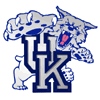 | 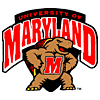 |
![]()
[Link to All-Time Series Results]
Overview
The series between the University of Kentucky and the University of Maryland has been relatively short, yet has recently taken on a more important turn as both teams vie for national honors. There have been three distinct eras which saw action between the two schools. The first was in the late 20's and early 30's when the game was still developing. The second was a flurry of activity in the mid- to late-1950's when the basic framework of the game had arrived, however the athleticism and power had yet to be fully harnessed. Finally, a third era has been seen in the late 1990's and beyond which exemplifies the culmination of over 100 years of development in this American sport.
Game-by-Game Summary
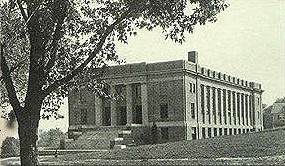 |
| Ritchie Gymnasium |
Kentucky was led by first-year head coach John Mauer, who came to Lexington from the University of Illinois. He ended up staying three years and leading the Wildcats to as successful a run as had been seen by the school up to that point. Maryland was coached by H. Burton Shipley, who was in his fifth year at the helm of the 'Ole Liners'. Shipley appears to be the one most responsible for starting Maryland's early basketball tradition. After many years without fielding a team, it was Shipley (then a student) who captained the second Maryland team ever in 1911. Two more years of inactivity followed but by 1914, Shipley was again captain of the squad.
Basketball at Maryland in the early part of the century was sporadic, largely owing to an absence of adequate facilities. This led to many instances where no team was assembled at all for many seasons. Finally in 1923, the first true gymnasium on campus was built, and that allowed Maryland to field a team for the first time since 1919. It was Shipley once again who took the reigns, this time as head coach. He would remain in the post for 24 years and effectively bring Maryland basketball through the dark ages of basketball into a more modern game.
The game with Kentucky, played before 1200 fans, proved to be a rout. Maryland's Julius 'Julie' Radice came off the bench and scored a game high ten points, as many points as the UM starters scored and three more than the team from Kentucky put on the board. Radice was assisted by fellow substitutes Thurston Dean and Ketzel, who each contributed six points. Kentucky was completely outclassed during the game, being held to the short end of a 16-1 margin at half and not scoring a field goal until six minutes remaining in the game. The Maryland defense proved too difficult a puzzle for the Wildcats to solve, and they ended up settling for perimeter shots through much of the second half, with little success. The final score was 37-7. The Maryland yearbook noted that "much more opposition was expected" by the visitors from the Bluegrass state.
[Boxscore] - 1927-28
 |
| H. Burton Shipley |
The game between the two was rough, but Kentucky built an early 5-1 margin and held on close to that margin through most of the contest, holding a 12-6 lead at halftime. The 'Old Liners' cut the margin to two, 19-17, midway through the second half but then the Wildcats scored 7 straight points to put the game out of reach. The final score was 26-21 UK.
Kentucky All-American Paul McBrayer led a balanced Wildcat scoring attack with eight points. Many of the shots by McBrayer and others came from the perimeter, twenty feet or more away. Maryland still counted Julius Radice among its ranks. Radice contributed five points, but it was another player, 6-foot-2 forward Louis 'Bosey' Berger from Fort Myer, Virginia who led the charge with eleven points on five field goals and one foul shot. According to legendary Atlanta columnist Morgan Blake, "The Kentucky Wildcats faced a very strong and determined club in the Maryland Ole Liners, who had a fine sharpshooter, named Berger, and the slickest passing gentleman we have seen in many days in a heavy-set chap named Radice. Mr. Radice was somewhat of a magician. He would look one way and pass another. And his passes were like Dazzy Vance's speed ball."
[Boxscore] - 1929-30 Southern Conference Tournament
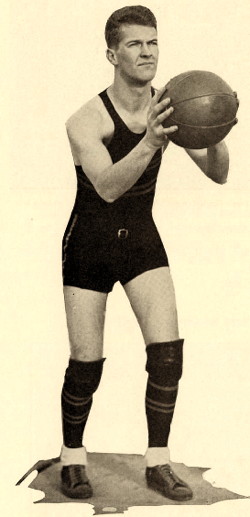 |
| Maryland's Louis "Bosey" Berger |
Maryland raced out to an eleven point lead by halftime, 18-7. The Wildcats were tight early on, and rushed their shots to no avail. Maryland also gained an advantage by double-teaming the Kentucky pivotman, George Yates. Also, Spicer was under the weather the entire tournament and he failed to score a point in the final game of his illustrious career. On the offensive side of the court, Berger put on a shooting exhibition, with many of his goals coming from far out on the floor. The Old Liners also made good on a bit of trickery, with two goals scored from an out-of-bounds play when the Maryland player cut towards the goal, received the ball and scored an easy crip.
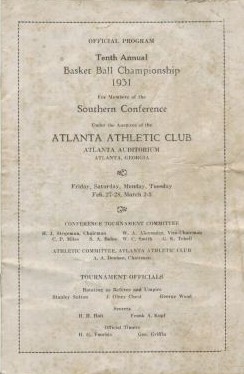 |
The first score was a thing of beauty as Berger received a full-court length pass and went in for the crip without breaking stride. The early 30's was still a very cumbersome game, characterized by stand-still two-handed set shots, rough deliberate play and center jumps after every score. It must have been a revelation for the spectators present to see in Berger's play a glimpse of the athleticism and grace which would define the game of basketball in the decades to come.
According to Atlanta columnist Larry Caudill, "But when May took the ball out of bounds with 40 seconds to go Berger signaled him with a waggle of the left thumb and set sail for the basket. May heaved the ball with all his might. The flying Berger took the glance at the ball in midair and reached the basket simultaneously with the sphere. He simply directed it into the basket with a flip of the fingers and the score was tied. It was the perfect exemplification of the most remarkable sense of timing and co-ordination ever exhibited in the tournament."
That feat was soon topped however, as Maryland won the resulting tip and Berger found himself with the ball at center court. He launched the game winning shot from there, and it hit nothing but net. Game Maryland.
The exhibition by Berger was so fantastic that it caught the imagination of all Atlanta sports fans. Wrote a well-known Atlanta columnist who used the byline of "The Ole Timer," "Another claim that might be made for the tournament is that it produced in the person of Louis Berger, of Maryland, the greatest southern player of the decade. Word still is heard of the consummate skill of Stewart, of Vanderbilt, and Cobb and Carmichael, of North Carolina, but old and fish-eyed critics were saying Tuesday night that Berger had proved himself the greatest of them all. It was Louis Berger who frustrated Kentucky. Not only did he hold the dashing boys from the Bluegrass at bay when they were fighting with frenzy for their long-denied championship, but he bombarded them with a fusillade of six gorgeous shots that hit the bullseye to score 12 points. Two of these shots came in the final minute of play and turned a 25-to-27 score into a 29-to-27 victory."
Berger was named All-American that year and received the award again in 1932. He eventually entered major league baseball where he played the infield for the Indians, White Sox and Red Sox. His major league baseball career lasted six years before he entered the armed forces prior to the US involvement in World War II. Berger remained in the military until he retired. He died in 1992.
[Boxscore] - 1930-31 Southern Conference Tournament Championship
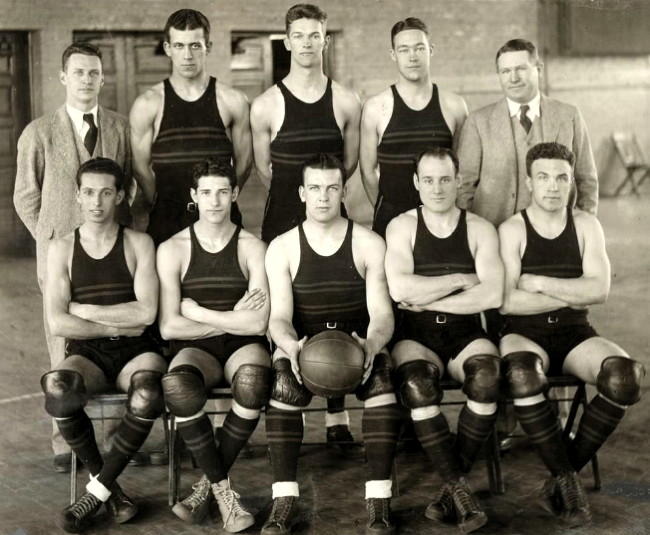 |
| University of Maryland - 1931 Southern Conference Champions Seated (l to r): Morris Cohen, Edward Ronkin, John Pitzer, Charlie May, George Chalmers Standing: Asst. Coach Faber, Jay Norris, Louis Berger, Bob Wilson, Head Coach Shipley |
That game proved to be the last one between the two schools for nearly 25 years. Probably the only constant at that time was that Kentucky's Rupp was still coaching in Lexington. In the intervening years, he had transformed the University of Kentucky from a regional power in basketball to not only a national power, but the preeminent program in college basketball at the time.
Maryland had gone through a number of changes themselves. In 1953, they broke away with a number of other Atlantic state schools and formed the Atlantic Coast Conference, which would prove to be a basketball power for decades to come. In addition, the school had just finished building Cole Field House which was a much larger building than Ritchie Coliseum which had been used previously since the mid-1920's.
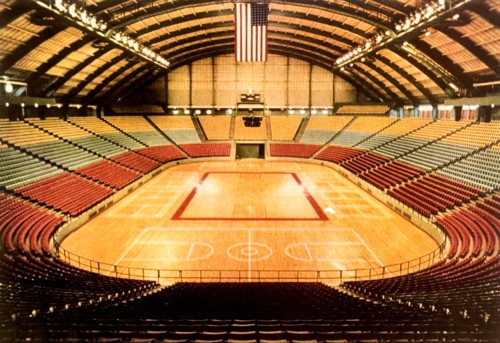 |
| Cole Fieldhouse |
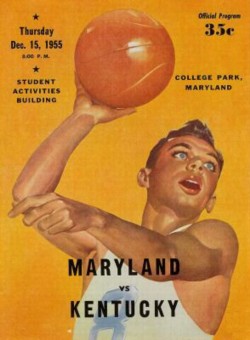 |
Kentucky was returning to College Park for the first time since 1928, and their embarrassing defeat. This time Kentucky was in better shape, ranked #12 in the nation while the Terrapins were unranked. Kentucky sprinted ahead in the first half 20-8, largely due to their hot shooting of 42 percent (considered very good during those days), with many of the shots coming over Maryland's zone defense. Maryland was forced to switch to the man-to-man and this paid dividends, as the margin was whittled down to a more respectable 3-point deficit, 32-29. This didn't last long, however, as Kentucky went on a run and ended the half with an 8-point lead.
Maryland fought back in the second half and the game remained tight throughout most of the period. Bob Kessler was the spark-plug for the Terrapins and he ended up with a game-high 23 points. With only about 4:30 left in the game, Maryland went ahead of the Wildcats 60-57. However after that, the game was all Kentucky's sophomore Vernon Hatton. Hatton, who would later in his career prove to be one of the most clutch players in Kentucky history, scored the last five points to put Kentucky back on top. Maryland had a chance to tie with 40 seconds remaining but Bob O'Brien missed the second of his free throws. Kentucky chose to freeze the ball, but the tactic almost backfired as Maryland regained possession in the waning moments. There was not enough time, however, to take a decent shot at the goal and Kentucky came away the victors. Kentucky was led by little Gerry Calvert with 19 points, while Hatton added 15.
[Boxscore] - 1955-56
 |
| UK's Gerry Calvert (#10) and UM's John Nacincik (#33) reach for a loose ball. Also identified in the photo are UK's Beck and UM's Drew Schaufler (#60) |
The return game of the 4-game series saw the Terrapins travel to Lexington KY and imposing Memorial Coliseum. This time, another Kentucky sophomore stole the show. His name was Johnny Cox and he electrified the crowd with a 34-point outburst. Cox was so hot he outscored the entire Maryland team 20-17 in the first half, en route to a 30-17 UK halftime lead. Third-ranked Kentucky went on to win the game 76-55. Maryland was led by Perry Moore and Nick Davis, each of whom scored 15 points.
[Boxscore] - 1956-57
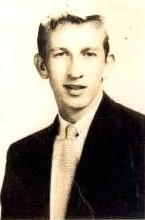 |
| Vernon Hatton |
The game was nip-and-tuck throughout most of the contest, with the score being tied 19-times in the first 33 minutes, including a halftime deadlocked at 33 points. But it was the final seven minutes of the game where the road-weary Cats started to show cracks and eventually fell apart. The Wildcats would score just three more field goals during the remaining seven minutes of the game, at a time when Maryland's John Nacincik would go on a shooting spree and the Terrapins scored 21 points to finish out the game. Nacincik scored 16 of his game-high 20 points in the second half, and Al Bunge added 18. Kentucky was led by Adrian Smith with 17 points.
Kentucky would lose more games that year, but somehow late in the year they pulled together and made an improbable run at the NCAA championship, which they ended up winning in the final against Seattle and their star player Elgin Baylor.
[Boxscore] - 1957-58
 |
| Bud Millikan |
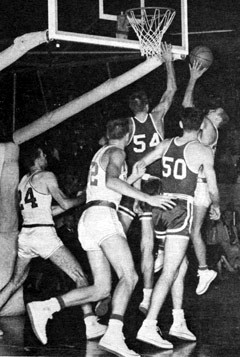 |
| Bennie Coffman scores and is fouled by Al Bunge to put the game into overtime |
The extra period was filled with missed shots and errors in ballhandling, yet Kentucky managed to score four points on a 15-foot shot from All-American Johnny Cox and two free throws from little Dickie Parsons. Maryland hit two free throws and had multiple opportunities to tie the score in the final minute but couldn't convert. Cox led Kentucky's scoring efforts with 18 points, while Maryland was led by Charles McNeil with 21. Said Rupp after the game in which Kentucky was outshot from the field 21-17. "I'm going to see my calves tomorrow and I'm giving the boys a day off...I've seen enough of that tough, rugged, nasty Maryland defense and I figure the boys want to forget about it too."
[Boxscore] - 1958-59
Rupp's words probably lasted longer than even he imagined, as he never faced Maryland and their "nasty" defense ever again. After the 1958 contest, Kentucky and Maryland did not face each other on the court for nearly 30 years. But that didn't prevent Kentucky from travelling to College Park to play basketball games in Cole Fieldhouse. In fact, they did it twice, however the outcome was bitter both times for the Wildcats.
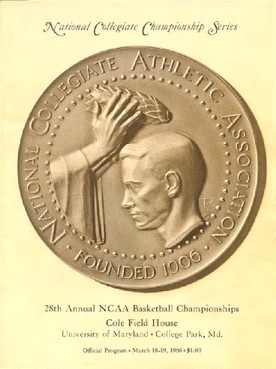 |
| 1966 Final Four Program |
The national championship game was held the very next night and matched the smooth-shooting squad from Kentucky against a tough defensive team from El-Paso Texas, Texas Western. Western was led by a young Don Haskins who was a disciple of Oklahoma State's Henry Iba. Playing in such a remote part of the country, Western was largely unknown before the tournament, despite rising to a #3 ranking in the AP poll. Even during the tournament, they were not considered to be on par with Duke and Kentucky that year, largely owing to their near defeats to Cincinnati (a game won by 2 points in overtime) and Kansas (a game won by 1 point in double overtime after a disputed call) and a struggle against Utah in the semifinal.
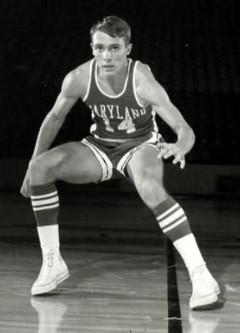 |
Despite the less than stellar play, the game has gone down as one of the most important contests in college basketball history. The reason being it was the first time in NCAA finals history that a team comprised of all white players competed against a team of all black players. (Western actually had a number of white and hispanic players on its roster, but none of them entered the game that night.) This game would be pointed to as a watershed event in sports history and as the emergence of the black athlete, despite the fact that it was already abundantly clear from the decade previous that black players had established themselves as a permanent force in the sport of basketball. Players such as Wilt Chamberlain at Kansas, the championship teams of San Francisco with Bill Russell and K.C. Jones, the champion Cincinnati powerhouses in the early 1960's and more recently the championship Loyola Chicago Ramblers (who started four black players in the championship game) all had proven the point. Yet it was the game in 1966 which is most often mentioned.
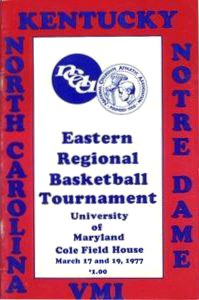 |
| 1977 Regional Program |
The game was a classic, with rough play, arguments and gutty performances the norm. Kentucky was trailing 55-43 when Phil Ford ran into a screen and after the collision, found he couldn't lift his arm. However Kentucky couldn't capitalize as UNC guard John Kuester ran Smith's 'four-corners' to perfection to run out a large amount of the game. The Tar Heels shot an amazing 33 of 36 free throws (as compared to Kentucky's 16 of 18 free throws), 14 of which came down the stretch as the Tar Heels didn't score a field goal the rest of the game. Late in the game, Kentucky's Rick Robey fouled Kuester particularly hard to stop the clock. The violence of the foul prompted Smith to run out on the floor and berate Robey, and according to Robey, called him a "cheap son of a bitch." Despite the drama, North Carolina went on to win the game and send Kentucky home from Cole, once again with a bitter pill to swallow.
When Maryland and Kentucky finally met again on the floor, it was in Cincinnati's Riverfront Coliseum for the 1988 NCAA Tournament second round. Sophomore guard Rex Chapman was the star for the Wildcats, yet his wrist was ailing after the first-round game against Southern because he had 'dunked too much.' Chapman played a miserable first half, going 1-for-6 from the field and the free throw line. Yet it was his back-court mate Ed Davender and fifth-year senior forward Winston Bennett who kept the Cats competitive in the first half.
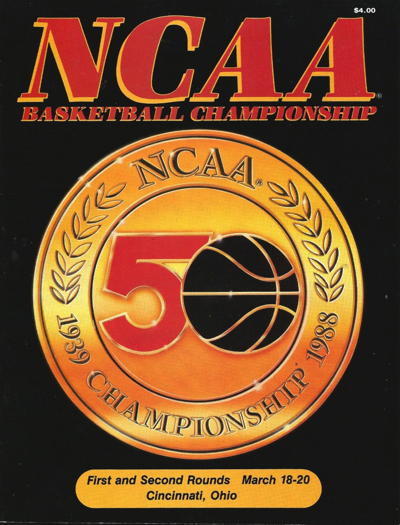 |
| 1988 NCAA Program |
As the second half began, Chapman regained his shooting touch and finished the game with 23 points, tied with Davender for game-high scoring honors. Maryland seemed to lose focus late in the game and stopped getting the ball to Williams inside, instead opting for perimeter jumpers. The jump shots were effective enough to keep Maryland in the game and it was two three pointers which tied the score 76-all with three minutes remaining. But it was then that Winston Bennett would secure the win. After the score was tied, Bennett received the ball in the post on a set play. He scored the go-ahead points against Derrick Lewis who was saddled with four personal fouls. On the next play down the court, Bennett stripped the ball from Lewis and Davender recover the loose ball. After that, Kentucky didn't look back and Maryland could not mount a comeback.
Unfortunately for the two programs, this game would in many ways be the last hoorah for a long time. Kentucky went on to lose to Villanova in the next game and then lose their star player when Chapman bolted for the NBA after his sophomore year, to go along with losing three senior starters. Kentucky faced real difficulties off-the-court after allegations began to surface of NCAA violations within the program. The fall-out was immense as Kentucky was investigated by the NCAA and put on probation. Most of the 'star' players would transfer and their coach Eddie Sutton would leave under pressure after the 1988-89 season.
Maryland too would experience some of the same problems, as they saw their coach, Bob Wade, leave after a dismal 1988-89 season. At around the same time, the NCAA investigated Maryland also and found NCAA infractions. As it turned out, the game played in 1988 was voided due to the use of ineligible players, not just on the Kentucky end but on the Maryland end also. So this game truly is 'the game that never was.'
 |
| Winston Bennett finishes a fast-break |
[Boxscore] - 1987-88 - NCAA Tournament
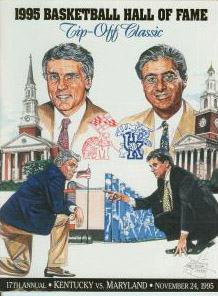 |
| Game Program |
The setting for the next matchup between the schools was the Tip-Off Classic, held in Springfield, Mass. Kentucky was ranked #1 preseason and looking to have as good a season as any in Kentucky history. Quite a statement, but that squad had the talent to back it up. 14th ranked Maryland would provide the first test of the Wildcat's strength.
As oftentimes happens in college basketball, the unexpected occurred. Maryland raced off to an 11-point lead, 20-9 within the first five minutes. But Kentucky came back and led by two points at halftime. UK then went on a 18-3 run in the second half and it looked like there was no turning back. But Maryland made a run, in large part due to Johnny Rhodes and his career high 30 points along with the free throw shooting of Duane Simpkins, who went a perfect 12 for 12 from the line. But Kentucky's depth finally wore down the Terrapins and Tony Delk scored six straight points late in the game to allow Kentucky to open a 10-point lead. The Wildcats went on to win the game 96-84.
Kentucky senior center Mark Pope led the Wildcats with 26 points, a career high for him, while Delk added 21.
[Boxscore] - 1995-96 - Tip-off Classic
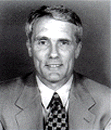 |
| Gary Williams |
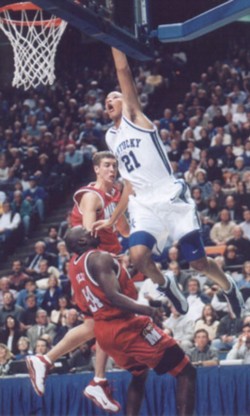 |
| Tayshaun Prince |
With the gauntlet of words thrown down, the two teams finally got into action. The action was furious for most of the first half, and Maryland was able to pull ahead. But Kentucky came back, largely on the effort of seniors Heshimu Evans and Scott Padgett. Kentucky ended the first half on a 21-8 run and led at halftime 54-41. Kentucky had shot a blistering 56% of their field goals in the half, to 39% for Maryland.
Maryland, led by Terence Morris and Francis, tried to get back into the game but Kentucky held a nearly 10-point margin through most of the half. Freshman Tayshaun Prince was assigned to be the primary defender of Francis and he did well to limit the All-American to only 25 hard-earned points before Francis fouled out with a minute left. Maryland came within four points twice in the final minute but Kentucky eventually pushed ahead and won the game 103-91. Heshimu Evans finished with a career high 31 points while Padgett added 25. Magloire chipped in six blocked shots to help the Wildcat cause. Said Francis after the game, "They were constantly coming after me. I didn't do anything to Kentucky, I don't know why they came after me. They didn't knock me down. They knocked Maryland down."
This game also marked the first time new Kentucky coach Orlando "Tubby" Smith faced Maryland as a head coach at UK (he had beaten Maryland earlier as coach at Georgia). Smith had grown up in Maryland and was a star player at Great Mills High School in the late 1960's. He was interested in playing at Maryland, in some part due to Billy Jones and the other black pioneers of the time, and was offered a scholarship by then coach, Frank Fellows. However before he would enroll, there was a coaching change and Charles "Lefty" Dreisell became the head coach in College Park. Dreisell had higher aspirations for the talent level of his teams and chose not to honor the commitment to Smith, who went elsewhere and ended up playing at High Point College in North Carolina under Jerry Greene.
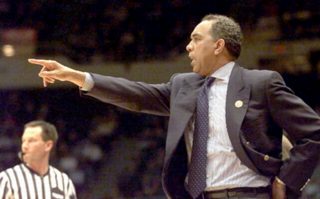 |
| Orlando "Tubby" Smith |
[Boxscore] - 1998-99
The next game saw the two match up the following year in the Preseason NIT in New York's Madison Square Garden. Gone from the Terrapins was Steve Francis , who bolted to the NBA after one season in College Park. But Terence Morris was back and was surrounded by a number of good young players including Lonny Baxter , Steven Blake and Juan Dixon. Kentucky was led by Tayshaun Prince and center Jamaal Magloire. A Kentucky freshman who was expected to contribute heavily was Keith Bogans. Bogans had come to Kentucky from the famed DeMatha High School, nearby to the Maryland campus. He was a prized recruit coming out of high school and Maryland was one of the many disappointed schools who were not able to sign him.
The game was uptempo and Kentucky seemed to thrive in the environment, blowing out to a 40-24 point lead in the first half at one point. Bogans had his first breakout game of the young season, scoring 17 points while Prince led UK with 21 points. Said Bogans "The first couple games, I relied on my jump shot. That's not really my game. It's slashing to the hole. I tried to start that way." Coach Smith attributed some of the success to the pace of the game. "It might have had something to do with the style of play. He [Bogans] reminds me of Heshimu Evans. Heshimu had a great game against Maryland. When you're facing a pressing team, you can catch guys one-on-one in the open floor."
But the good times didn't last for Kentucky. Maryland made a strong bid to get back into the game, largely on the shoulders of All-American candidate Terence Morris who had 25 points and always seemed to play well against Kentucky. Kentucky didn't help matters by shooting less than 50% from the free throw line down the stretch. Maryland got within 3 in the final minute, but Juan Dixon missed a couple of crucial three-pointers which could have changed the outcome. Said Dixon, "I had open looks. I just didn't knock them down. If we hit two or three more shots, we win the game."
[Boxscore] - 1999-00 - Preseason NIT
The following game was held a few weeks after the match in New York. This time, Kentucky returned to Cole Fieldhouse nearly 44 years to the day after they helped dedicate the arena. Many commentators made mention that this was the first time Kentucky had returned to Cole since the 1966 National Title game (a game which had grown in significance with each passing year), conveniently forgetting the fact that Kentucky had actually last played in Cole in 1977.
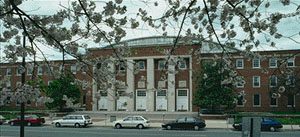 |
| Cole Fieldhouse |
The Maryland crowd was into the game from the first tip and this seemed to energize the Terrapins. Kentucky seemed to take up where they left off in the second half with poor shooting and costly turnovers, and the Wildcats soon found themselves behind, trailing at halftime 34-27. Maryland, on the other hand, eased off on their press and found that their man-to-man defense was paying dividends as Kentucky turned the ball over and Maryland converted. It was Terence Morris who once again led the Terrapins. He scored 22 points while Steven Blake added 16 and Juan Dixon 15 points. Kentucky went on a 7-0 run early in the second half to cut the lead to three points but Maryland responded and held the Wildcats at bay. With 1:30 left in the game, Kentucky had pulled within two points only to see Blake run out ahead of the pack and receive a pass for an uncontested layup to put Maryland ahead by four. Kentucky would never threaten again and the Terrapins would win 72-66.
Said Morris about the game, "Kentucky had our number the last few years. We wanted to prove we could play with that team. And we can."
[Boxscore] - 1999-00
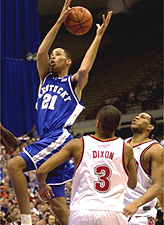 |
| Tayshaun Prince |
Kentucky jumped out to the early lead, on good three-point shooting by Kentucky junior Keith Bogans. However, Maryland went on a 15-3 run to go from a 19-14 deficit to a 29-22 advantage. Kentucky got back into the game, but once they got to within three points at 33-30, they committed four straight turnovers and did not cut the lead further. In the final seconds of the half, Maryland's Chris Wilcox drove for a dunk which put Maryland ahead 39-33.
The second half saw Maryland make a concerted effort to push the ball inside, and Maryland's big men Lonny Baxter and Chris Wilcox responded. "We gave away a lot of weight to them, and they took advantage," said UK Coach Tubby Smith. Kentucky's own big man, Marquis Estill, rose to the challenge and scored 12 points of his own in the second half, but his efforts weren't enough, especially on the defensive end, to stop the Maryland attack. Kentucky did continue to scrape and had many chances to pull close, however late in the game they started to blow critical opportunities. Bogans missed the front end of two one-and-ones, Tayshaun Prince missed a number of jumpers and the team committed a number of critical turnovers which prevented Kentucky from making up lost ground. "It was more of what we didn't do," said Coach Smith. "We didn't take advantage of a couple of fast-break opportunities and turned the ball over two or three straight times. That just took the wind out of our sails. You could tell the guys started to show some doubt at that point."
Maryland, on the other hand, never lost control of the situation and calmly hit their free throws down the stretch, as Kentucky began to foul to stop the clock. Maryland finished the night hitting 21 of 24 free throws en route to a 78-68 victory. Dixon led the Terrapins with 19 points while Baxter added 16 and Wilcox 15. Kentucky was led by Tayshaun Prince with 17 points.
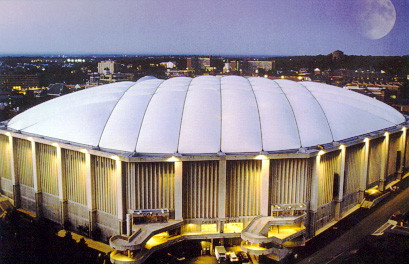 |
| The Carrier Dome in Syracuse, NY |
Maryland advanced through the tournament that year and eventually won their first NCAA crown in school history.
[Boxscore] - 2001-02 - NCAA Tournament
![]()
Please note that the following reference materials were consulted for the above. 1.) Lexington Herald (and Lexington Herald-Leader) 2.) Louisville Courier Journal 3.) Baltimore Sun 4.) University of Maryland Media Guide 5.) University of Maryland website among others.
Return to Kentucky Rivalries, Maryland Series Results, statistics, teams, opponents, players, coaches, opposing coaches, games or search this site.
Page written by Jon Scott. Please with any corrections or additional information.
Last Updated October 4, 2012